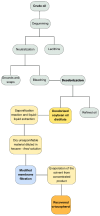Innovative Trends in Modified Membranes: A Mini Review of Applications and Challenges in the Food Sector
- PMID: 39452821
- PMCID: PMC11509346
- DOI: 10.3390/membranes14100209
Innovative Trends in Modified Membranes: A Mini Review of Applications and Challenges in the Food Sector
Abstract
Membrane technologies play a pivotal role in various industrial sectors, including food processing. Membranes act as barriers, selectively allowing the passage of one or other types of species. The separation processes that involve them offer advantages such as continuity, energy efficiency, compactness of devices, operational simplicity, and minimal consumption of chemical reagents. The efficiency of membrane separation depends on various factors, such as morphology, composition, and process parameters. Fouling, a significant limitation in membrane processes, leads to a decline in performance over time. Anti-fouling strategies involve adjustments to process parameters or direct modifications to the membrane, aiming to enhance efficiency. Recent research has focused on mitigating fouling, particularly in the food industry, where complex organic streams pose challenges. Membrane processes address consumer demands for natural and healthy products, contributing to new formulations with antioxidant properties. These trends align with environmental concerns, emphasizing sustainable practices. Despite numerous works on membrane modification, a research gap exists, especially with regard to the application of modified membranes in the food industry. This review aims to systematize information on modified membranes, providing insights into their practical application. This comprehensive overview covers membrane modification methods, fouling mechanisms, and distinct applications in the food sector. This study highlights the potential of modified membranes for specific tasks in the food industry and encourages further research in this promising field.
Keywords: compounds recovery; food science; fouling; membrane; membrane modification; nanotechnology.
Conflict of interest statement
The authors declare no conflicts of interest.
Figures






References
-
- Issaoui M., Jellali S., Zorpas A.A., Dutournie P. Membrane Technology for Sustainable Water Resources Management: Challenges and Future Projections. Sustain. Chem. Pharm. 2022;25:100590. doi: 10.1016/j.scp.2021.100590. - DOI
-
- Keskin B., Ersahin M.E., Ozgun H., Koyuncu I. Pilot and Full-Scale Applications of Membrane Processes for Textile Wastewater Treatment: A Critical Review. J. Water Process Eng. 2021;42:102172. doi: 10.1016/j.jwpe.2021.102172. - DOI
-
- Pervez M.N., Mishu M.R., Stylios G.K., Hasan S.W., Zhao Y., Cai Y., Zarra T., Belgiorno V., Naddeo V. Sustainable Treatment of Food Industry Wastewater Using Membrane Technology: A Short Review. Water. 2021;13:3450. doi: 10.3390/w13233450. - DOI
-
- Charcosset C. Classical and Recent Applications of Membrane Processes in the Food Industry. Food Eng. Rev. 2021;13:322–343. doi: 10.1007/s12393-020-09262-9. - DOI
-
- Yadav D., Karki S., Ingole P.G. Nanofiltration (NF) Membrane Processing in the Food Industry. Food Eng. Rev. 2022;14:579–595. doi: 10.1007/s12393-022-09320-4. - DOI
Publication types
LinkOut - more resources
Full Text Sources
Miscellaneous

